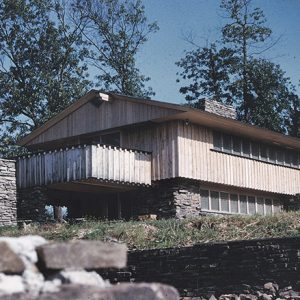calsfoundation@cals.org
E. Fay and Gus Jones House
The E. Fay and Gus Jones house, located at 1330 N. Hillcrest Avenue in Fayetteville (Washington County), has been the residence of architect Fay Jones (1921–2004) and his wife, Mary Elizabeth “Gus” Jones (1921–2014), as well as their two daughters. Completed in May 1956, it was designed by Jones upon his return to Fayetteville after a short period of employment in the office of Frank Lloyd Wright. A skillful composition of stone, wood, and glass, sheltered by a deeply overhanging roof, the Jones house is emblematic of the organic principles Jones sought in his work and shows the influence of his experiences with Wright.
Jones selected a lot adjacent to a wooded area at the northern edge of town, situating the house with the main façade facing west. All major interior spaces faced east, where they would capture the rising sun. He located the main entry behind the house, requiring visitors to discover the house and grounds as they arrived. Collaborating with his builders, Jones improvised many details by sketching ideas as work continued. During initial excavation for the house, an obstructive rock ledge was encountered. Jones decided to incorporate the rock into the design, creating a grotto-like main entry area in the lower level of the house, complete with plantings and a small ornamental pool. This arrangement served to connect the exterior and interior spaces, an idea common to the best work of both Frank Lloyd Wright and Fay Jones.
The presence of the rock ledge amplified the cave-like qualities of the entry level and was further enhanced by soft lighting, low ceilings, and stone flooring. This level included a children’s bedroom, a bathroom, and an area for the architect’s design studio. The wood-framed second floor was organized around a large, centrally located stone hearth and included all major living areas and the master bedroom suite. In contrast to the shadowy lower level, the woodsy, tree house–like upper level was made bright and open, with expansive views in nearly all directions, and included a terrace balcony along the east and north façades. Here, Jones explored new combinations of space; for instance, the open-planned living area extended to include the master bedroom, which served double duty as an extension to the living room when entertaining.
The house proved a popular architectural pilgrimage site from the date of its completion. Wright himself conferred his approval to Jones when he visited the house during a trip to Fayetteville in 1958. Throughout his career, Jones valued Wright’s pursuit of the principles of nature and architecture, especially a building’s relationship to the ground, how its profile was made visible against the sky, and how it utilized simple materials in an effortless, dignified manner. These principles contributed to Wright’s idea of “organic” architecture, and Jones was able to translate his mentor’s principles into his own. The Jones house serves as an early example of his philosophy, foreshadowing his globally recognized work to come. The house was listed on the National Register of Historic Places on April 28, 2000. It was donated to the University of Arkansas in 2015 by the Jones heirs for the purpose of preserving the architect’s legacy, to encourage greater appreciation of his work, and to stimulate historic preservation design education. With the donation, a complete restoration was undertaken in order to preserve the house for many years to come. Completion is expected by late 2018.
For additional information:
“E. Fay and Gus Jones House.” National Register of Historic Places nomination form. On file at Arkansas Historic Preservation Program, Little Rock, Arkansas. Online at http://www.arkansaspreservation.com/National-Register-Listings/PDF/WA0830.nr.pdf (accessed September 13, 2021).
“E. Fay & Gus Jones House, 1330 North Hillcrest Avenue, Fayetteville, Washington County, AR.” Library of Congress, Historic American Buildings Survey. http://www.loc.gov/pictures/item/ar1146/ (accessed September 13, 2021).
Ivy, Robert Adams, Jr. The Architecture of E. Fay Jones, FAIA. Washington DC: The American Institute of Architects Press, 1992.
Gregory Herman
University of Arkansas, Fayetteville
 World War II through the Faubus Era, 1941 through 1967
World War II through the Faubus Era, 1941 through 1967 E. Fay and Gus Jones House
E. Fay and Gus Jones House 




Comments
No comments on this entry yet.